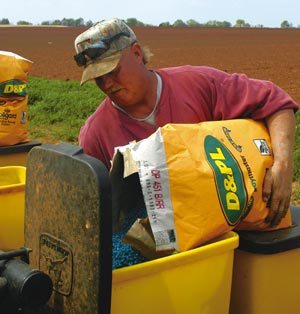Alabama Farmers To Plant More Corn, Less Cotton, Peanuts

Like many Alabama farmers, Henry County Farmers Federation President Sammy Williams is planting a little less cotton than he did last year. The reasons: higher costs of production and low commodity prices.”The initial cost of growing cotton is a lot more, and with fuel costs as high as they are this year, it’s going to be even higher,” Williams said. “Plus, cotton farming was rough in our area last year, and some farmers have had problems renting land because their landlords don’t understand the new farm bill.”Williams planted 340 acres of corn and expects to plant 500 acres of peanuts as well as 350 acres of cotton–about 10 percent less cotton than last year. Statewide, the Alabama Agricultural Statistics Service predicts farmers will plant 580,000 acres of cotton, down 10,000 acres from last year. The Statistics Service also predicts total peanut acreage will drop 10,000 acres to 180,000 acres. Although Williams has not shifted his peanut acreage to other crops, he knows some farmers who have.”In this area, there are a few people who are not planting peanuts at all,” he said. “Because of the price, they just can’t pencil in a profit. If you don’t make between 2,500 and 2,700 pounds, it’s going to be hard to make a profit.” Williams said the 2002 Farm Bill eliminated the peanut quota program, which had a price support rate of $610 per ton for “quota” peanuts. Under the new farm bill, the support rate is $495 for 85 percent of a farmer’s base acres. Additional peanuts can be placed in a loan program at the rate of $355 per ton.Covington County farmer Glen Walters said the changes to the peanut program have caused a shift in some peanut acreage from the Wiregrass to southwest Alabama. Meanwhile, he took advantage of provisions in the farm bill that allowed producers to update their base acres and yields, but he expects to plant about the same acreage of peanuts and cotton as last year.In the Tennessee Valley, Limestone County farmer Robert Lauderdale said he expects to plant 2,500 acres of cotton, 250 acres of corn and 250 acres of soybeans. “We’re planting a little more corn than we’ve been having, but we mainly use corn as a rotation crop.”Limestone County Extension Coordinator Curtis Grissom said he wouldn’t be surprised to see other farmers planting more corn and less cotton.
“The price is a little better for corn than it has been in the last few years,” Grissom said. “Farmers also need to rotate their crops because we have a severe reniform nematode infestation.”Despite higher prices for corn, Limestone County farmer Brent Shaw said he is planting all cotton again this year because the cost of diversifying is too high.”If I were to plant corn, I would have to buy a $200,000 combine, a $100,000 truck and $50,000 worth of on-farm storage,” he said. “It’s hard to justify that kind of expense.” Instead, Shaw has cut his costs of production this year by reducing the number of trips he has to make over his fields. According to the Statistics Service, Alabama farmers expect to plant 220,000 acres of corn this year, up 10 percent. Meanwhile, wheat plantings were down 20 percent to 120,000 acres, and total soybean acreage was expected to fall to 150,000 acres, down 12 percent.Nationally, cotton acreage is expected to top 14.2 million acres, up 2 percent from last year. Farmers intend to plant 1.2 million acres of peanuts, down 8 percent, while corn and soybean acreages are expected to be basically unchanged.
